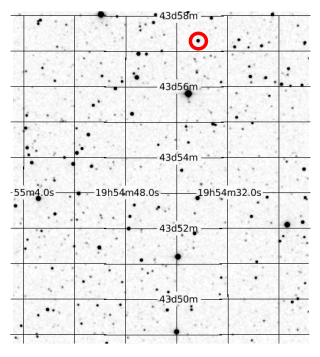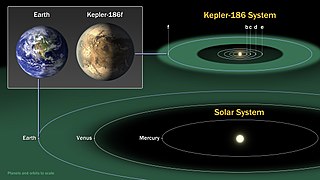
An exoplanet or extrasolar planet is a planet outside the Solar System. The first possible evidence of an exoplanet was noted in 1917 but was not recognized as such. The first confirmation of detection occurred in 1992. A different planet, initially detected in 1988, was confirmed in 2003. As of 1 February 2023, there are 5,307 confirmed exoplanets in 3,910 planetary systems, with 853 systems having more than one planet. The James Webb Space Telescope (JWST) is expected to discover more exoplanets, and also much more about exoplanets, including composition, environmental conditions and potential for life.
Kepler-80, also known as KOI-500, is a red dwarf star of the spectral type M0V. This stellar classification places Kepler-80 among the very common, cool, class M stars that are still within their main evolutionary stage, known as the main sequence. Kepler-80, like other red dwarf stars, is smaller than the Sun, and it has both radius, mass, temperatures, and luminosity lower than that of our own star. Kepler-80 is found approximately 1,218 light years from the Solar System, in the stellar constellation Cygnus, also known as the Swan.

Kepler-138, also known as KOI-314, is a red dwarf located in the constellation Lyra, 219 light years from Earth. It is located within the field of vision of the Kepler spacecraft, the satellite that NASA's Kepler Mission used to detect planets transiting their stars.

Kepler-186 is a main-sequence M1-type dwarf star, located 178.5 parsecs away in the constellation of Cygnus. The star is slightly cooler than the sun, with roughly half its metallicity. It is known to have five planets, including the first Earth-sized world discovered in the habitable zone: Kepler-186f. The star hosts four other planets discovered so far, though they all orbit interior to the habitable zone.

Kepler-186f is an exoplanet orbiting the red dwarf Kepler-186, about 580 light-years from Earth.
Kepler-298d is an exoplanet orbiting Kepler-298, 473.69 parsecs away. Kepler-298d was discovered in 2014, it orbits its star in the Habitable zone. Kepler-298d was thought to be an Earth-like planet, further research shows that its atmosphere is +2.11 on the HZA scale, this means the planet may be an ocean planet with a thick gas atmosphere like a dwarf-giant.

Kepler-438b is a confirmed near-Earth-sized exoplanet. It is likely rocky. It orbits on the inner edge of the habitable zone of a red dwarf, Kepler-438, about 472.9 light-years from Earth in the constellation Lyra. It receives 1.4 times our solar flux. The planet was discovered by NASA's Kepler spacecraft using the transit method, in which the dimming effect that a planet causes as it crosses in front of its star is measured. NASA announced the confirmation of the exoplanet on 6 January 2015.
Kepler-296e is a confirmed Earth-sized exoplanet orbiting within the habitable zone of Kepler-296. The planet was discovered by NASA's Kepler spacecraft using the transit method, in which the dimming effect that a planet causes as it crosses in front of its star is measured. NASA announced the discovery of the exoplanet on 26 February 2014.
Kepler-296f is a confirmed super-Earth exoplanet orbiting within the habitable zone of Kepler-296. The planet was discovered by NASA's Kepler spacecraft using the transit method, in which the dimming effect that a planet causes as it crosses in front of its star is measured. NASA announced the discovery of the exoplanet on 26 February 2014.
Kepler-296 is a binary star system in the constellation Draco. The primary star appears to be a late K-type main-sequence star, while the secondary is a red dwarf.
Kepler-182 is a star in the constellation of Cygnus. In the night sky, it is located at right ascension 19h 21m 39.2s and declination +38° 20′ 38″. The star is notable for having two planets in the circumstellar habitable zone.
Kepler-24d is a transiting exoplanet orbiting the star Kepler-24, located in the constellation Lyra. It was discovered by the Kepler telescope in February 2014. It orbits its parent star at only 0.051 astronomical units away, and at its distance it completes an orbit once every 4.244384 days.
Kepler-24e is a transiting exoplanet orbiting the star Kepler-24, located in the constellation Lyra. It was discovered by the Kepler telescope in February 2014. It orbits its parent star at only 0.138 astronomical units away, and at its distance it completes an orbit once every 19 days.
Kepler-26e is an exoplanet orbiting the star Kepler-26, located in the constellation Lyra. It was discovered by the Kepler telescope in February 2014. It orbits its parent star at only 0.220 astronomical units and completes an orbit once every 46.8 days. It is potentially habitable.
Kepler-186e is a confirmed exoplanet orbiting the red dwarf star Kepler-186, approximately 582 light years away from Earth in the constellation of Cygnus. It is near the optimistic habitable zone but probably not in it, possibly making it have a runaway greenhouse effect, like Venus. The exoplanet was found by using the transit method, in which the dimming effect that a planet causes as it crosses in front of its star is measured. Four additional planets orbiting the star were also discovered.

Kepler-1229b is a confirmed super-Earth exoplanet, likely rocky, orbiting within the habitable zone of the red dwarf Kepler-1229, located about 870 light years from Earth in the constellation of Cygnus. It was discovered in 2016 by the Kepler space telescope. The exoplanet was found by using the transit method, in which the dimming effect that a planet causes as it crosses in front of its star is measured.
Kepler-160 is a main-sequence star approximately the width of our Galactic arm away in the constellation Lyra, first studied in detail by the Kepler Mission, a NASA-led operation tasked with discovering terrestrial planets. The star, which is very similar to the Sun in mass and radius, has three confirmed planets and one unconfirmed planet orbiting it.
Kepler-174 is a K-type main-sequence star located in the Milky Way galaxy at a distance of about 1,254 light-years away from the Sun. It is located inside the boundaries of the Lyra constellation, but it is too dim to be visible to the unaided eye and is not part of the main outline.
Kepler-167 is a K-type main-sequence star located about 1,119 light-years (343 pc) away from the Solar System in the constellation of Cygnus. The star has about 78% the mass and 75% the radius of the Sun, and a temperature of 4,884 K. It hosts a system of four known exoplanets. There is also a companion red dwarf star at a separation of about 700 AU, with an estimated orbital period of over 15,000 years.








